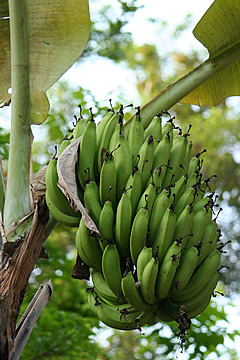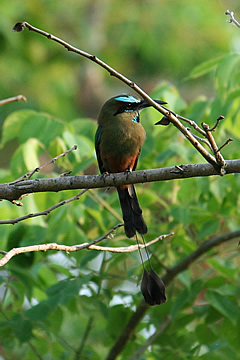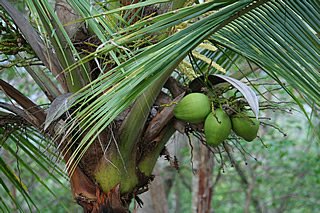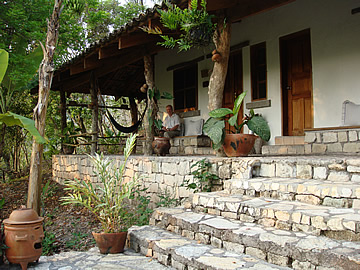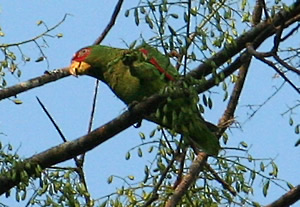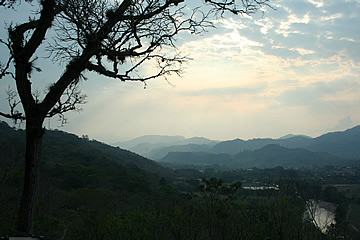

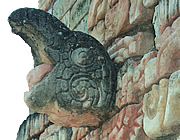
There is a huge amount to see at Copan, the extensive ceremonial centre of an important Mayan City. The Hieroglyphic Stairway and tunnels are highlights in an amazing collection of ancient structures.
Copan Ruinas, the village, was fun during a fiesta.
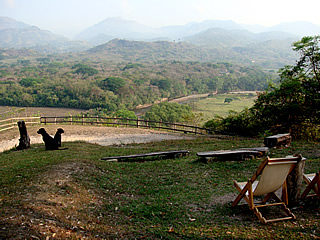
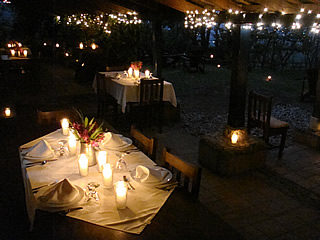
Driving across the border from Guatemala with our guide Mario we approached the small town of Copan Ruinás. Mario gave us a short orientation tour then took us across the Copan river and up into the hills to our hotel, the Hacienda San Lucas.
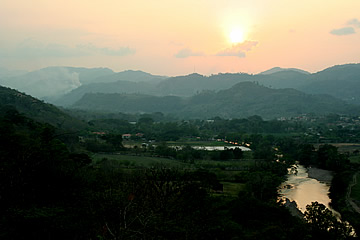
It is in a very peaceful location, high up above the town and river and the ancient city ruins of Copan, though little of these can be seen due to the surrounding jungle! It's a lovely spot to watch the sunset and spot the local birds. We could also see lots of fires burning where the farmers were clearing the fields ready for planting.
It was late when we arrived so after watching the sunset, cool beer in hand, we were ready for dinner at the beautifully lit tables on the terrace. Afterwards to our room to sleep - while at dinner candles had been lit in the room.
The following morning we hitched a lift with one of the hotel pick-ups to get us to the ruins of Copan otherwise it would be a long walk. The owner had also said we could get a lift back if we went to their office in the afternoon which was a relief as it's all uphill back to the hotel!
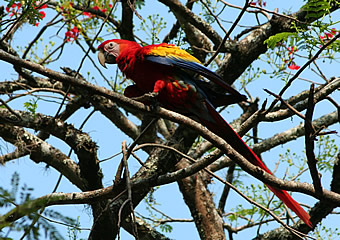
Down to the river there are chili fields under cover and two old tobacco drying sheds, no longer in use.
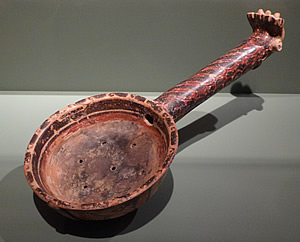
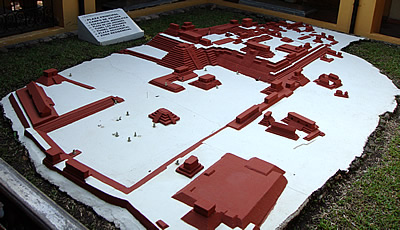
Mario wasn't allowed to guide us in Honduras so we decided to buy a good guide book and do it ourselves. At the entrance is a model of the site which is always useful to get bearings.
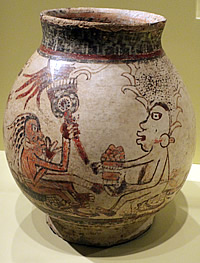
Scarlet macaws fly freely here, beautiful flashes of colour through the trees.
Copan flourished from 400 A.D. when it was founded by the first ruler K'inich Yax K'uk' Mo', also known as Great-Sun and First Quetzal Macaw. For over four hundred years the city developed its ceremonial, political and civic centre to a magnificent degree, adding pyramids, temples, palaces and numerous stelae and "altars" with successive rulers.
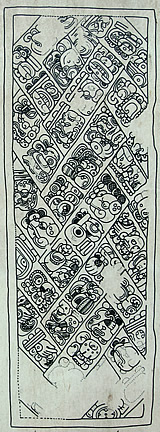
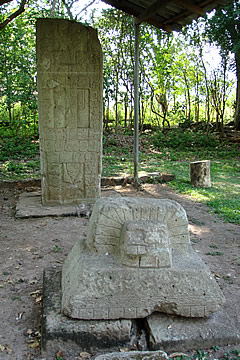
Though never as large as Tikal, at its peak it probably sustained over 20,000 people who lived in urban areas outside the centre. It was strong enough to hold sway over nearby smaller cities such as Quirigua. 18 Rabbit of Copan made K'ak' Tiliw ruler at Quirigua in 725AD, though in 738 18 Rabbit was captured and beheaded at Quirigua. Mayan society was often at war, blood sacrifices were common - the greater the standing of the victim, the more pleasing in the eyes of their gods.
We entered the Great Plaza, a huge open space mostly constructed in the early eighth century by the great ruler Waxaklajun Ub'ah K'awil, the thirteenth ruler of the Copan dynasty. He was also known as 18 Rabbit because a figure on his identifying glyph was thought to look a bit like a rabbit! His name actually translates as "18 are the images of the god K'awil".
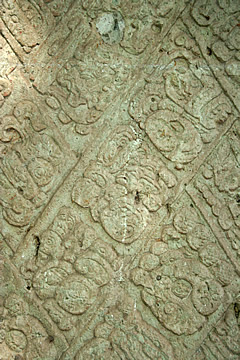
On the eastern boundary of the Great Plaza, passing through an area of unexcavated mounds, stands Stela J, dating from 702 and the first recorded monument of 18 Rabbit's reign. He set it here to mark the boundary between the mortal world and the mystical world of the Great Plaza. It has a unique woven mat arrangement of hieroglyphs on its eastern face which give insight into the role of the Great Plaza.
The information board reads:
The side facing east away from the Great Plaza is carved in a mat pattern, a symbol of authority, and seems to read: "You are now entering the great square of the people, the holy place, where Waxaklahun Ubaah K'awiil, legitimate successor to "Ruler 12" K'ahk' Uti' Ha' K'awiil and K'inich Yax K'uk Mo', founder of the dynasty, will perform acts of ritual to mark the passage of time which will ensure your lives and prosperity."
The other side facing west towards the Great Plaza seems to read: "You are now leaving the Great Plaza of the people to return to the mortal world, which is ruled by the cycle of life and death." The stela refers to the mandate of the 13th ruler Waxaklahun Uva K'awiil and the end of the 9.0.0.0.0 period under the founder K'inich Yax K'uk Mo.
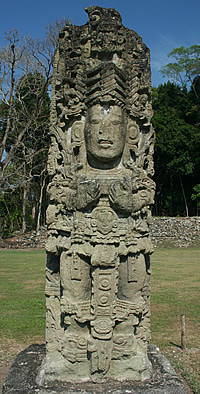
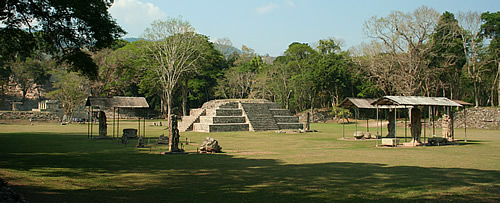
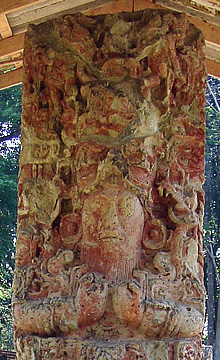
At the northern end of the Great Plaza itself, the area encompassed on three sides by long step platforms, which could have served as seats, and a small reconstructed radial pyramid at its southern end, is known as the Sun Court. It is here that we start to get a feel for 18 Rabbit, the rituals and beliefs of the time.
18 Rabbit ruled from 695 to 738 A.D. - a remarkable 43 years. He was responsible for much of what remains at Copan and most of what can be seen in the Sun Court.
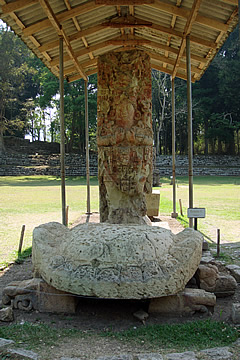
Within the Sun Court are seven carved stelae (A, B, C, D, F, H and 4 ; mayaruins.com helped with extra info on stelae in the Sun Court) and eleven carved stones. These stones are often called altars but it's not certain what their exact role was. Possible uses include as a throne during ceremonies, as a platform for incense burners or offerings, or as a sacrificial altar - many do have images of captives on them.
This Sun Court would have been the site of important ceremonies, principally rites of worship to the Sun God, K'inich Ahau, as well as solar observations. In effect the space had both ritual and astronomical importance.
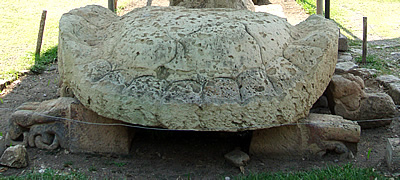
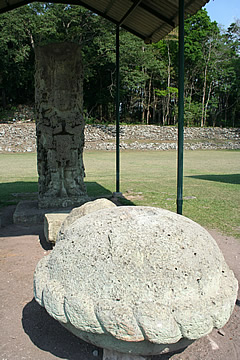
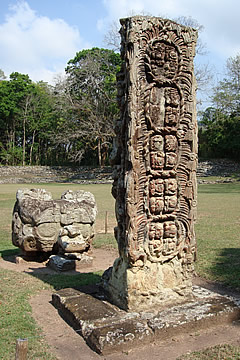
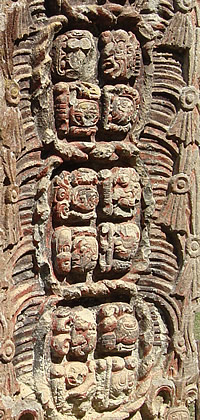
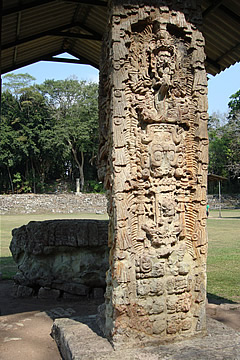
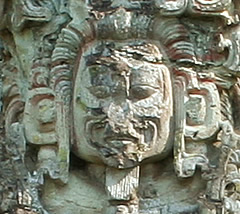
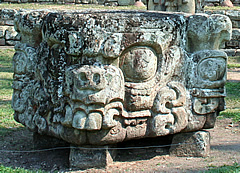
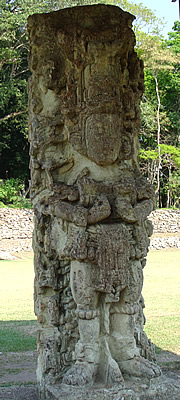
Though the stelae here are much smaller than those at Quirigua, around 3-5 metres high, they make up for it with beautifully deep carving, a style which only appears during the reign of 18 Rabbit.
On some stelae the sides are covered with informational hieroglyphs, on others the carving extends right around the stone. This three-dimensional style is a later development and can also be seen at Quirigua where it appears on stelae carved after 18 Rabbit was captured and killed by his protegée K'ak Tiliw at Quirigua. It may thus be that the style was copied from Copan as a triumphal sign.
Stela 4 is one of the more naturalistic forms, with roundly-carved arms and legs, standing on sturdy feet which are not flat against the face of the stela but angled outward.
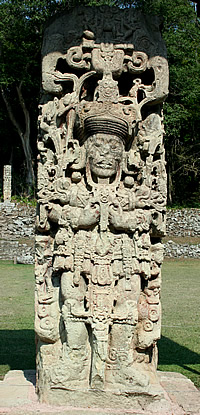
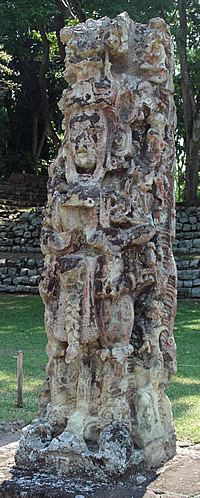
This style is also evident in Stela F. The carving of 18 Rabbit extends around the sides and the figure itself is very three-dimensional. In particular the legs are roundly curved and the feet in the traditional high-backed sandals are again fully formed and at a natural angle to the body.
The back of Stela F is also very beautifully carved with 5 sets of four hieroglyphs framed in a twisted rope.
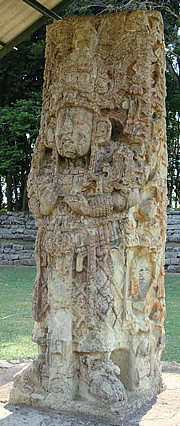
Stelae H and B were erected in 730 and 731 A.D. respectively and depict 18 Rabbit in elaborate costumes. Stela B was erected to mark the second end of a k'atun falling in 18 Rabbit's reign.
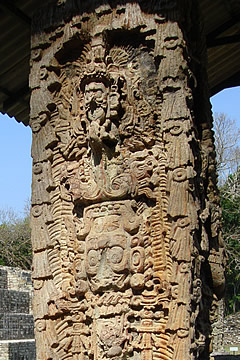
Uniquely in this group, in Stela H the ruler is clothed neck to toe and represents the Maize God, one of the primary gods of Mayan mythology associated with rebirth and new life.
The back of Stela H is another which is intricately carved, this time with a representation of the World Tree connecting the various cosmic levels.
At the north end of the Sun Court is 18 Rabbit's final stela erected 736 A.D., Stela D, and its wonderful Zoomorphic "altar", probably depicting the Earth Monster. Birth and death are symbolised by issuing from, or sinking into, the mouth of the Earth Monster.
Very unusually the face of 18 Rabbit is masked on Stela D. As with many of the stelae, traces of paint, particularly red, can be seen on the sculpture.
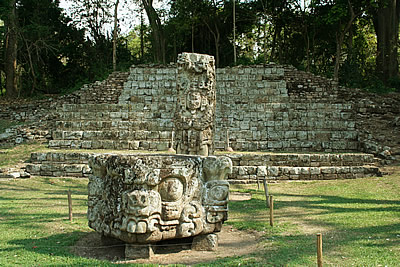
In front of it stand a fantastic Zoomorphic altar which really looks as if it might have been used for sacrificial purposes!
In 800 A.D. the sixteenth and final king in the dynastic line which began with the city founder, K'inich Yax K'uk' Mo', in 426, erected the last of three snake "altars" in the Sun Court. Each is in the shape of a double-headed feathered serpent: G3 and G2 erected in 766 and 795 are arched while G1 is solid. These are among the last monuments to be erected at Copan and very mysterious.


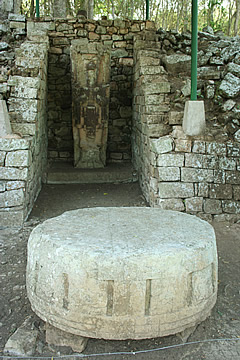
On the south east side of the plaza is the only stela which does not show 18 Rabbit. It is set into a niche of the surrounding platform and is in rather a poor state but does serve to demonstrate how sophisticated the carving became during 18 Rabbit's reign. This is of his predecessor K'ahk' Uti' Ha' K'awiil (Smoke Jaguar, Smoke Imix God K) and is much flatter than the almost free-standing sculptures of 18 Rabbit.
In front of it stands a classic drum "altar" - the type that really looks as if sacrifices could be made on it!
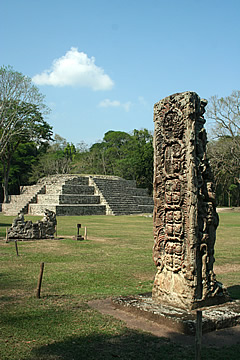
The south side of the Sun Court is marked by Structure 4, a square, stepped pyramid with a flight of steps on each side - this type of pyramid is known as a radial pyramid. It is aligned with the cardinal points and beautifully simple in design and was built by 18 Rabbit on the site of a much earlier structure dating from the time of the foundation of the city in the first half of the fifth century.
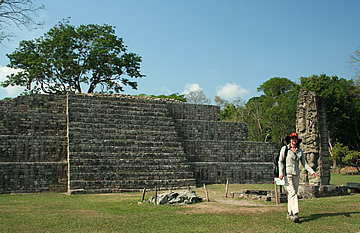
The Great Plaza starts to get even more interesting south of the radial pyramid where there is an enormous ballcourt.
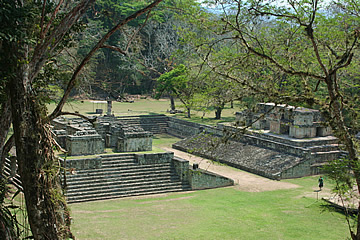
Mystery surrounds the game - even to the most basic facts such as whether it was a game at all. It could have been a ritual or ceremonial activity. At Copan the Ballcourt is decorated with macaws, strongly associated with the sun and its movement across the skies, and the ball game appears in stories from the ancient book of Mayan mythology, the Popol Vuh.
The game was played between two teams of an unknown number of players, maybe from as few as two per side. The ball was made from solid rubber and its size seems to vary up to football size. It could thus be extremely heavy. Players wore protective clothing, particularly some form of padded hip belt, as the aim of the game seems to have been to keep the ball in play by bouncing it off parts of the body, particularly hips and legs, but use of hands and feet was prohibited.
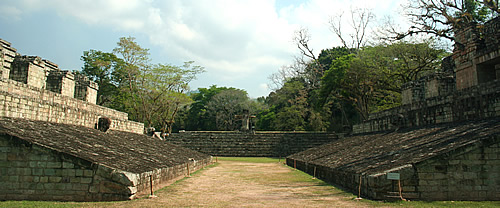
Some ballcourts have vertical rings set high in the sides of the opposing two walls and it would seem an obvious game play to get the ball through the ring - maybe this was a game-ender as it looks like a very difficult thing to do.
Sometimes defeated opponents were sacrificed to the gods but we were also told that it may have been the winners who were sacrificed, supposedly a great honour!
The whole performance may have been imbued with ritual significance, the winners ensuring health and prosperity for their city perhaps.
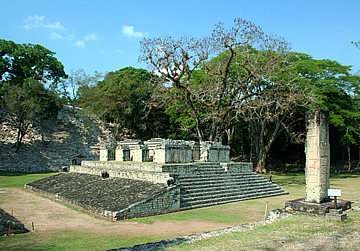
The ballcourt that we see today is due to 18 Rabbit, finished in 738 just a few months before his capture and death.
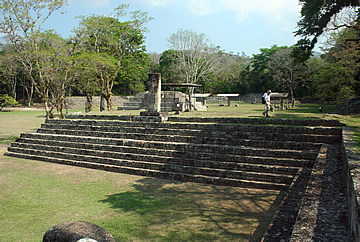
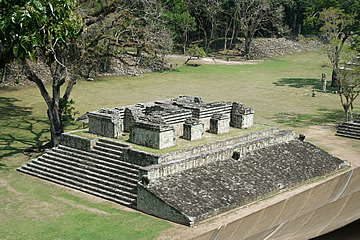
The sloping surfaces of the ballcourt are each decorated with three stone macaw heads, though these may also have had significance to the game.
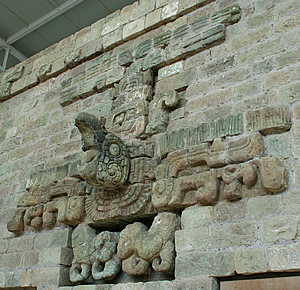
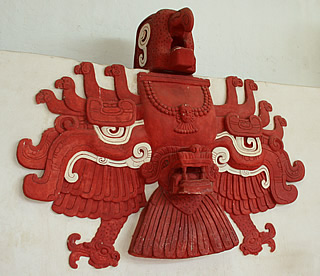
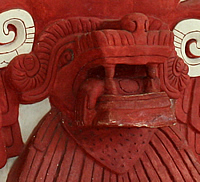
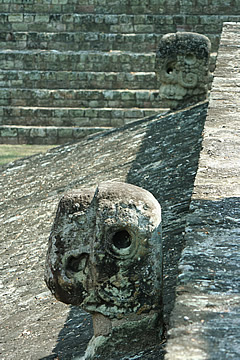
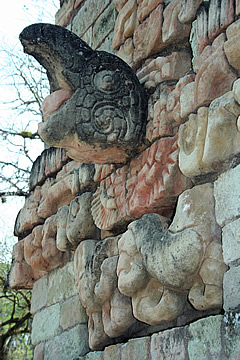
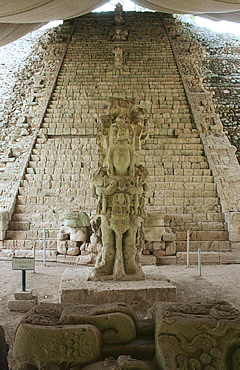
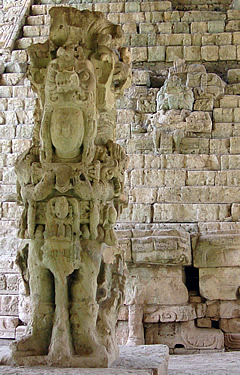
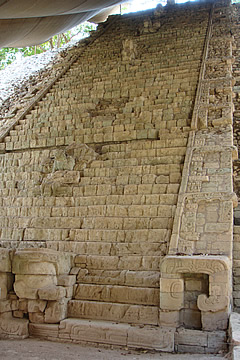
The temple walls above the ballcourt were also decorated with fabulous macaws, complete with flamboyant feathers and clawed feet. One has been reconstructed and placed on the west wall of the east temple; more can be seen in the excellent sculpture museum. In fact macaws adorned all versions of the ballcourt. On the earliest they were in red stucco and include a jaguar-like head carrying a severed arm in its jaws - perhaps a scene from the Popol Vuh when one of the Hero twins has his arm torn off by the fearsome Vucub-Caquix.
These decorative macaws are absolutely stunning. The ballcourt area must have been a magnificent sight when intact and fully painted, buzzing with the expectation of an exciting contest.
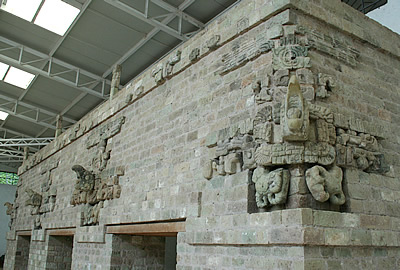
The magnificent 10 metre wide Hieroglyphic Stairway was commissioned by the 12th ruler Smoke Imix, embellished by the 15th ruler Smoke Shell, and completed by the 13th ruler, 18 Rabbit. Over 2,000 hieroglyphs running along the face of the blocks which make up the 63 steps honour the dynastic rulers of Copan beginning with the founder K'inich Yax K'uk' Mo. The hieroglyphs are now very worn. The stairway ascends the west face of Temple 26.
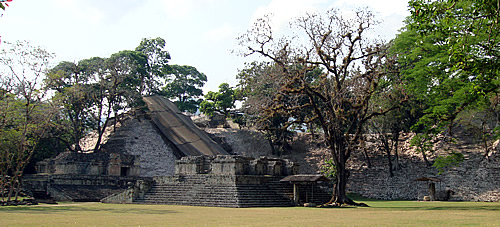
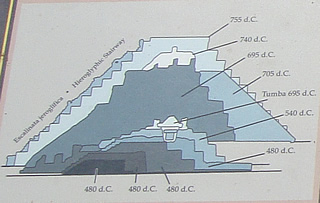
A great deal of meticulous archaeological work has revealed that the staircase is built over a number of earlier structures. The immediate preceding structure had a shorter hieroglyphic staircase with an inscription praising Smoke Imix and was topped by a now-buried temple which contained his tomb.
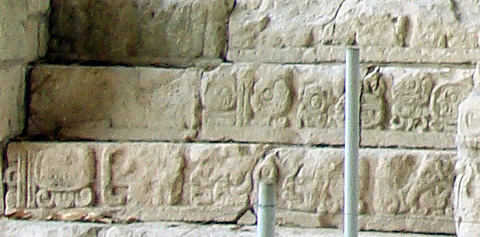
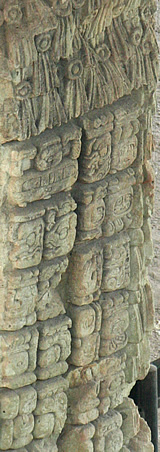
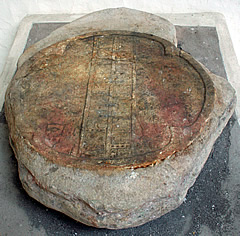
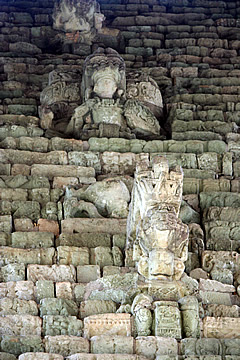
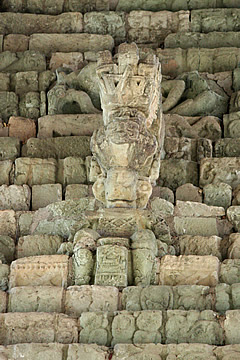
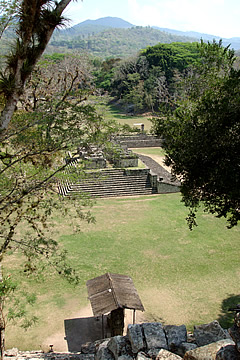
The two earliest structures, designated "Yax" and "Motmot" date from the time of the founder K'inich Yax K'uk' Mo.
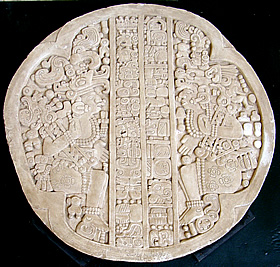
In the sculpture museum is the original "Motmot" stone, a beautiful floor marker cemented into the stucco floor above the tomb of a young woman in the Motmot pyramid (Fash et al in Understanding early classic Copan edited by Ellen E. Bell, Marcello Andrea Canuto, Robert J. Sharer). The floor marker bears the earliest hieroglyphic inscription of Copan commemorating the end of a Baktun: 9.0.0.0.0 (435 A.D. - for a brief intro to the Mayan date system see Quirigua) and the sealing of the tomb.
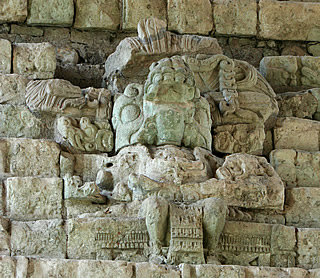
Structures, like people, had a finite lifetime for the Maya. When a new structure was to be built the old was "buried" with respectful ceremony, often with items relating to the purpose or patron of the building such as a broken stela or ceramics. Dedicatory caches are also found beneath other monuments such as "altars".
18 Rabbit created the longest Mayan inscription of hieroglyphs yet discovered on his staircase, extolling the virtues, achievements and lineage of past rulers, in particular his immediate predecessor Smoke Imix.
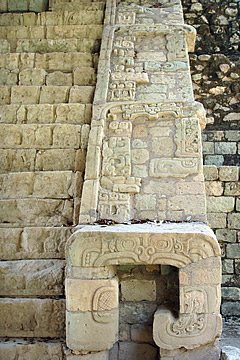
Smoke Shell further extended the staircase inscription and added the balustrades. His damaged stela stands at the base of the staircase with a Zoomorphic altar before it.
Spaced on the steps are a series of figures of the more important rulers.
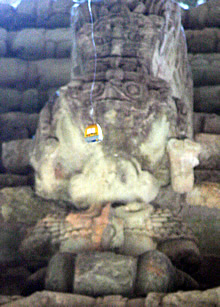
The rulers all appear to be in warrior dress wearing fearsome jawed masks and headdresses.
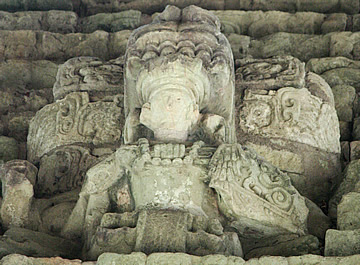
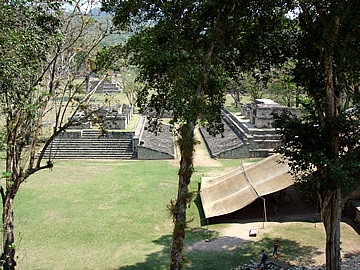
At the south end of the Great Plaza the Acropolis stands high above the plain, south of the Hieroglyphic Staircase which ascends Temple 26, projecting from the north end of the Acropolis.
The majority of the Acropolis is taken up by the East and West Courts where political and religious activities would have been concentrated since the time of the foundation of the city.
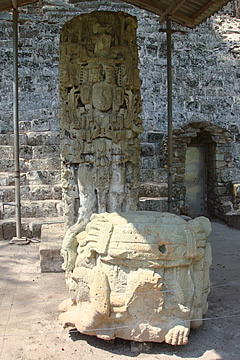
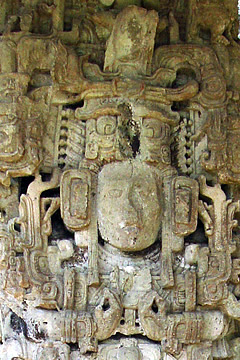
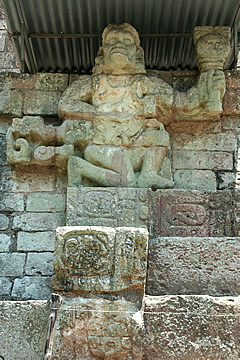
Temple 11, or the Temple of the Inscriptions, occupies the northern edge of the Acropolis west of Temple 26 and was reached by a monumental staircase from the south side of the Court of the Hieroglyphic Stairway. It was built by Yax Pasaj, the last great king of Copan, ruling at a time of imminent collapse of the civilisation in the early eighth century.
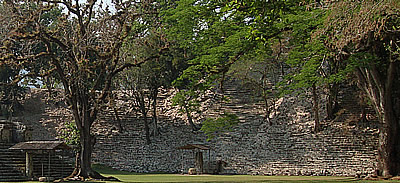
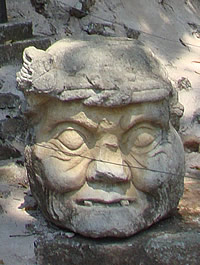
At each corner of the temple roof were positioned massive sculptures of Pauahtun, the gods who held up the heavens. A replica of one of the heads can be seen on top at the eastern edge of the temple ruins.
Temple 11 symbolized the portal to the underworld, destination of the royal spirits after death. On its south side it faces the West Court and below it is the Reviewing Stand.
Ceremonies were performed on the Reviewing Stand and probably included veneration of the spirits and perhaps sacrifices. The Stand carried symbols of the watery underworld in the form of large stone shells. It formed part of a symbolic ballcourt along with three markers in front of it on the ground of the West Court.
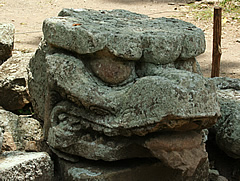
On either side at the top of the six hieroglyphic steps leading to the Reviewing Stand were stone carvings of kneeling figures, somewhat simian in appearance and probably a Monkey God, though I think this is a music or creator deity rather than anything to do with the underworld.
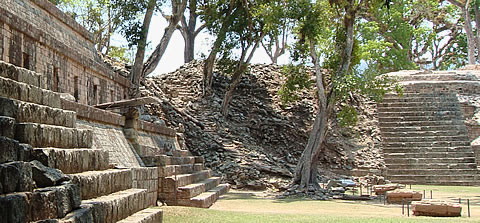
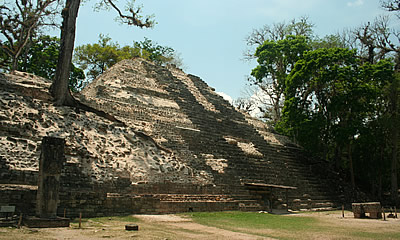
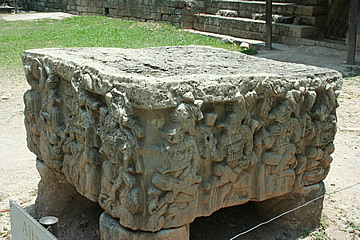
The east side of the West Court is the site of the massive Temple 16, the highest structure of the Acropolis. At the base of its 20m stairway stands probably the most important sculpture to be found her. Designated Altar Q it is square and carved on its four sides with all sixteen rulers of Copan. On the front (west side) of the altar the sixteenth ruler Yax Pasaj receives the baton of office on the date of his accession, 2 July 763, from the founder K'inich Yax K'uk' Mo and his 14 other predecessors. Each carved figure is identified by his glyph. The Altar standing outside is a replica - the original can be found in the excellent Sculpture Museum.
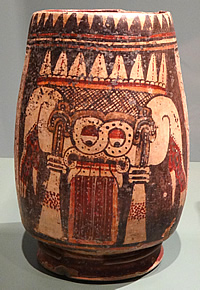
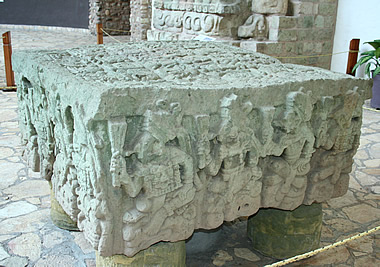
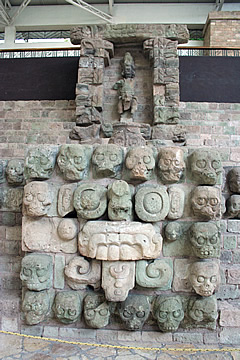
The stairway had three platforms, the lowest of which has been reconstructed in the museum. It depicts the god Chaac or Tlaloc, a deity associated with water, surrounded by skulls, continuing the theme of the West Court's symbolic function of representing the watery underworld.
Chaac was the Mayan rain god, depicted as a human with reptilian features, fish scales, a protruding lower lip, curly hair and a turned-up nose. He used a stone axe to create lightning.
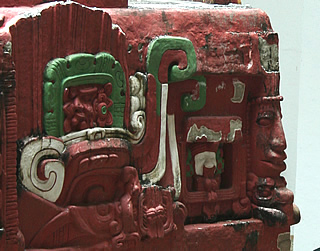
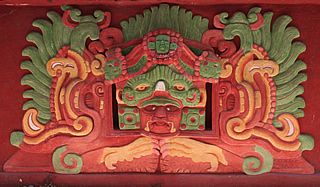
Tlaloc was the Central Mexican people's rain god, adopted by K'inich Yax K'uk' Mo, and readily identified by fangs and the goggles on his eyes.
The middle platform is described in the museum as being "framed by an ancestral sun disk, a rectangular feature with four serpent heads coming out of its corners. Usually a sun or moon sign is in the center. Here there is a figure of K'inich Yax K'uk' Mo' as the sun deity, surrounded by rope. We believe this structure commemorates past rulers and their power as warriors".
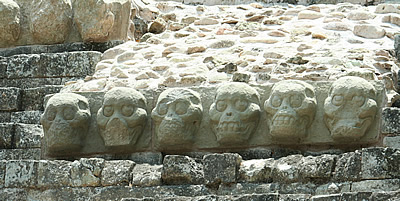
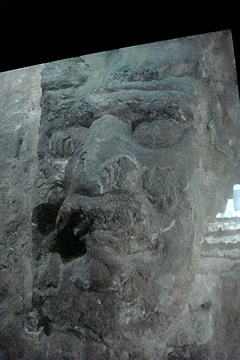
As with many Mayan buildings, Temple 16 was built over several previous structures. In this case some of the earlier buildings can be seen via tunnels in the East Court, a very atmospheric experience.
The 6th century "Rosalila" structure is the best-preserved in the tunnels, in fact it must have been especially venerated as most built-over buildings were at least partially destroyed - Rosalila was very carefully preserved standing in its own space.
A complete replica of Rosalila has been built in the Sculpture Museum giving a much better idea of its grandeur. The original dates from the 6th century and was brightly coloured, predominantly red with bright green, yellow and orange stucco masks which adorn the walls of the building. It measures approximately 18 by 12 metres and rises to a height of about 14m. Its main entrance faced west, the direction the Mayans associated with entrance to the underworld.
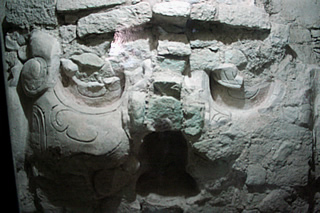
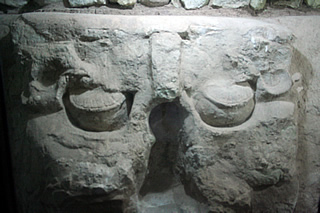
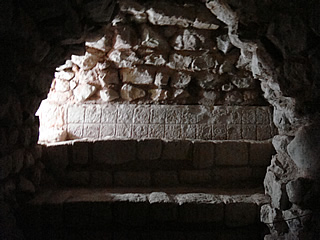
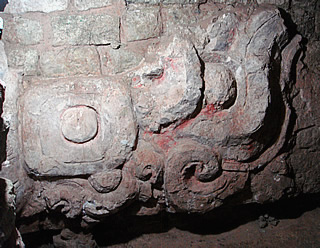
The tunnels are quite dark with intermittent illumination but some masks and carvings on walls of the structures are highlighted, and the building can be seen looming in the darkness, though the colours are difficult to make out - according to the guide book the facades were covered by a thick layer of white plaster at the end of the seventh century when a new structure was to be built over it.
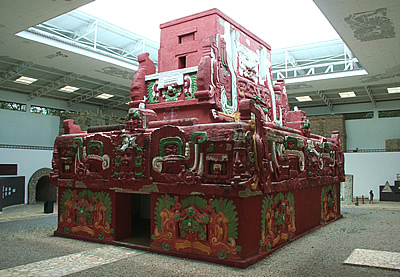
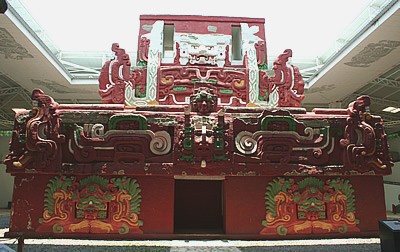
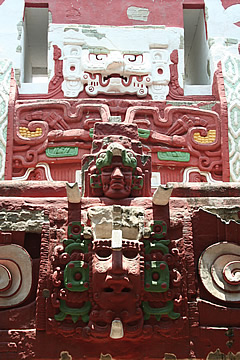
Each wall at ground floor level carries two colourful masks with images of the Sun God, K'inich Ahau, and the founder of the dynasty, K'inich Yax K'uk' Mo.
Above are masks of the Witz or Earth Monster, symbolic of the living mountain; positioned on a temple these transform the building into a living, sacred mountain in the eyes of the Maya.
In the tunnels another of the structures called "Ante" can also be seen. Hieroglyphic steps on the structure indicate that it was built by the eighth ruler around 540 A.D. There are some really nice bird masks here.
The tunnels are an amazing place to visit, with a real sense of delving into the past.
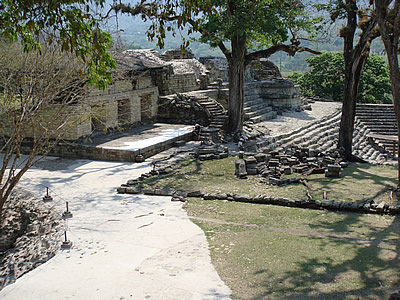
Temple 16 towers above the west side of the East Court.
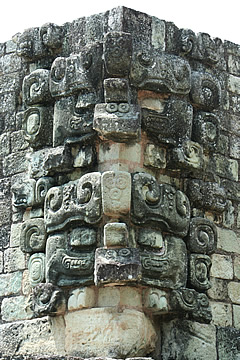
Temple 22, on the northern terrace of the East Court, was raised by 18 Rabbit to represent a portal to the underworld, continuing the theme which runs throughout the Acropolis.
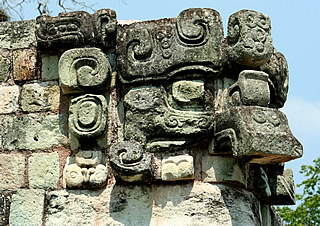
The doorway to the temple is the mouth of a giant Witz monster, representing an entrance to the living mountain and hence the underworld - Witz monster sculptures also adorn the exterior corners of the building. Inside, the inner sanctum was reached through an even more remarkable doorway: a Cosmic Monster incorporating representations of the Milky Way, Sun and Venus.
West of Temple 22 is the Popol Nah or Council House. The dedication date of the building was only eight years after the death of 18 Rabbit.
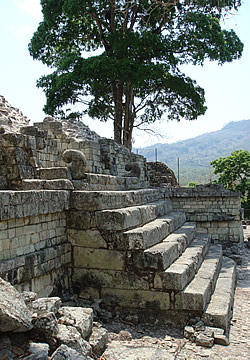
William L. Fash, responsible together with his wife Barbara for much of the work at Copan, postulates in his book Scribes, Warriors and Kings: The City of Copán and the Ancient Maya that the succeeding ruler, Smoke Monkey, presiding at a time of great uncertainty, may have built the Popol Nah as part of his strategy to stabilise his kingdom.
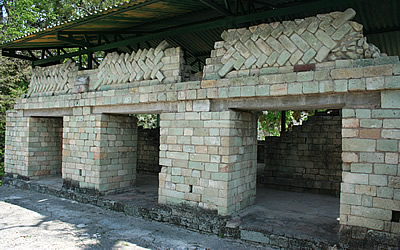
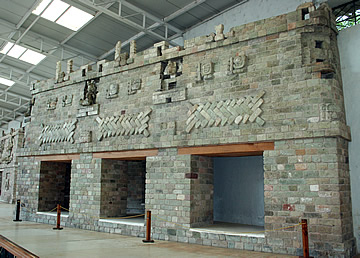
The building carries three large woven mat sculptures and carvings of human figures above place name glyphs. It seems likely that these represent provinces governed by Copan. Above these are a series of glyphs which read "ahau lil" meaning "governance" or "act of governing".
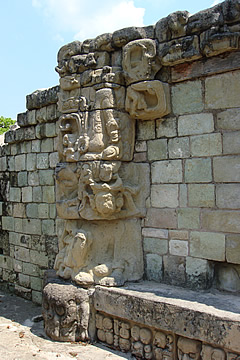
The building honours the governors and may have served to bind the provinces together more strongly.
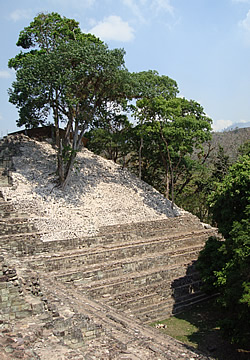
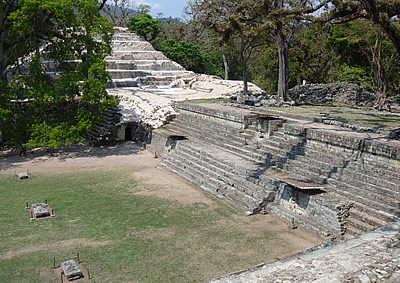
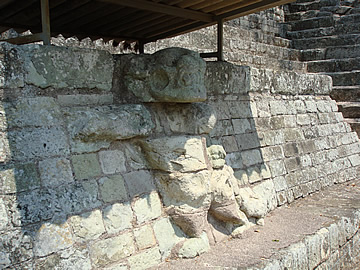
The guide book describes the East Court as a place of sun worship.
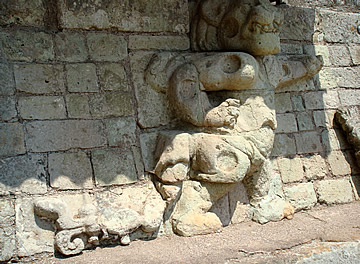
The west stairway has a sculpture of a Jaguar Sun God representing transformation into night. The west was the direction in which the sun disappeared every day and therefore was associated with the underworld.
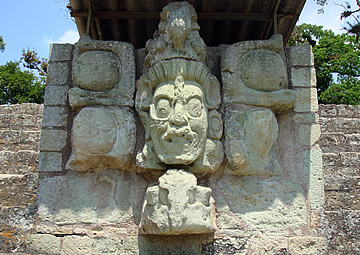
On the eastern stairway would have been a sculpture of a youthful Sun God, representing the dawn.
Two beautiful dancing jaguars, over two metres high, stand at the lower edge of the western stairway. Jaguars are nocturnal creatures but they are most active around dawn and dusk so these representations are particularly apt.
As in the West Court there are three stone markers set into the ground identifying the East Court also as a symbolic Ballcourt.

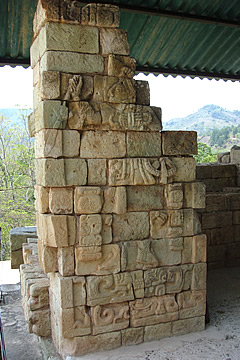
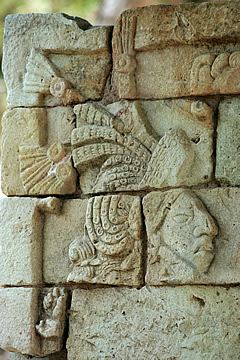
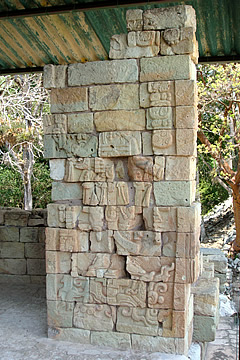
On the south-eastern corner of the Acropolis Temple 18 stands high above the East Court.
The eastern part of the temple has been swept away by the Copan River which has done a lot of damage on this side of the site.
The Temple celebrates Yax Pasaj Chan Yopaat, the sixteenth and final ruler of Copan. Images of the king performing war dances are carved into the walls, perhaps indicative of the turbulent times.
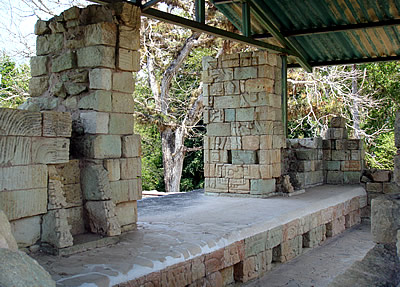
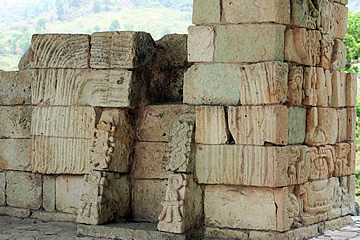
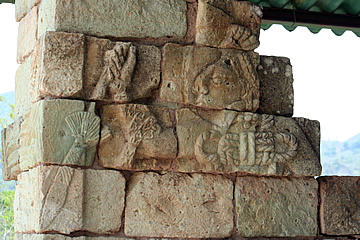
The temple is beautifully decorated on the walls and platform.
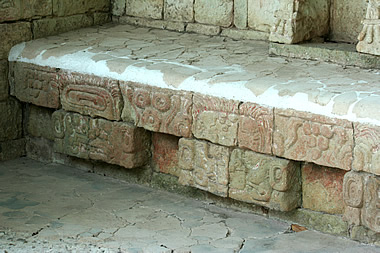
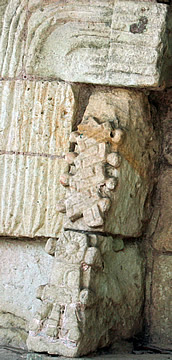
Yax Pasaj remodelled many of the buildings of the Acropolis - the last time that this would be done.
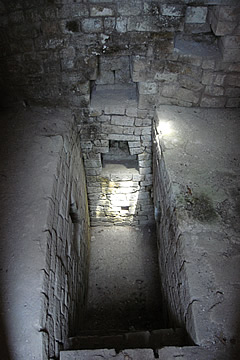
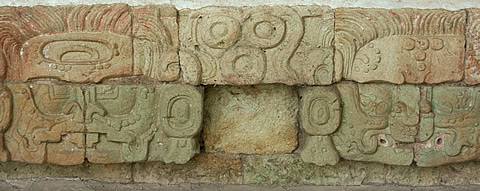
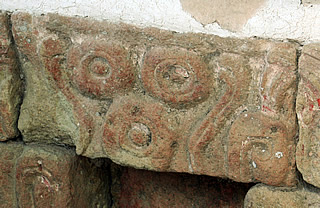
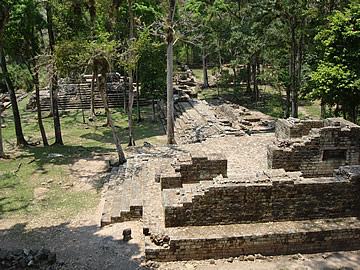
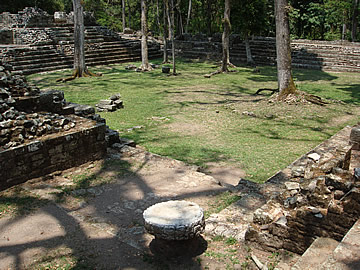
Yax Pasaj's tomb is located on the south-east corner of the temple reached by an outside staircase. It is well below the level of the temple and now looks very plain with empty niches in its walls.
South of the Acropolis is the royal residential area, sometimes called the Cemetery Group because of the large number of tombs found here. There are over 25 buildings, built around rectangular courtyards, and the majority of people were buried near to where they lived. They date mostly from the late classical period from 750 - 810 A.D. when Copan was in an imminent state of collapse. It's a very atmospheric area, half hidden in the jungle.
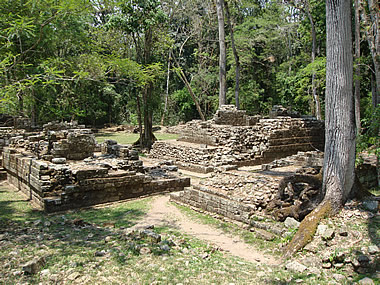

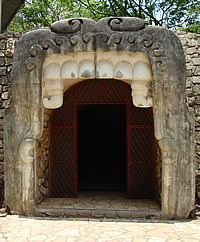
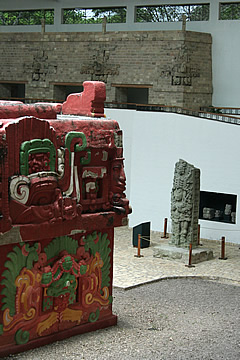
We had spent hours wandering around this fascinating site but we knew the museum was highly-acclaimed so spent some time in their too! The full-size replica of Rosalila is obviously the star but there are original stelae and sculptures plus several reconstructed building facades which make the museum unmissable.
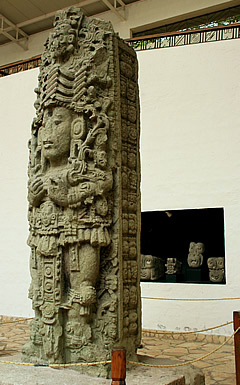
Copan is an amazing, extensive site which needs a good number of hours to explore thoroughly. It's hot and tiring but very rewarding.
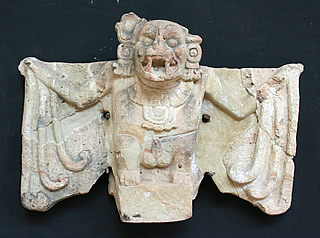
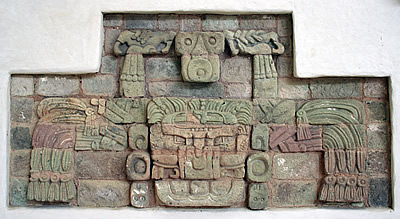
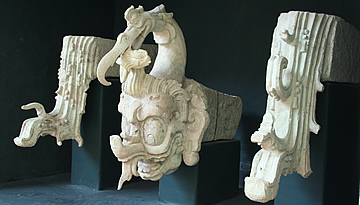
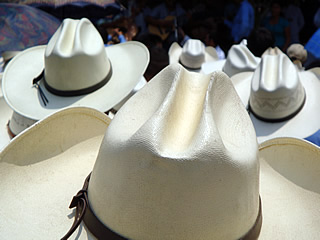
After a beer at the cafeteria a $3 tuk-tuk transported us into Copan Ruinas, where we discovered a fiesta for the May 1st holiday. Big crowds and lots of different bands playing on a stage in the piazza.
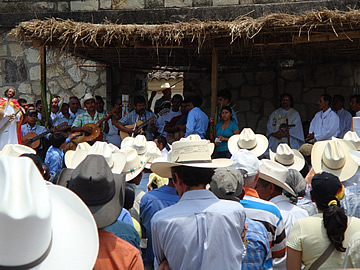
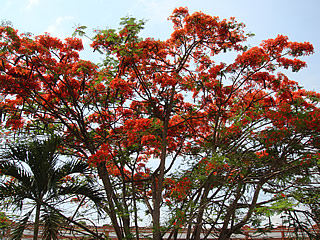
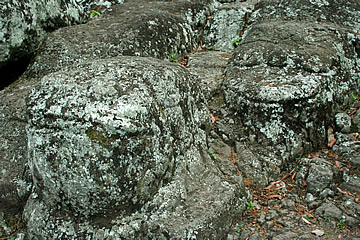
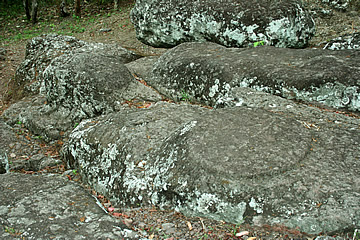
Back at the hotel, again a lift from the hotel pick-up otherwise it's a very long walk, we rested for a while before embarking on the hotel's very own archaeological trail. Through the forest an easy walk leads to a small Mayan site, Los Sapos - the Toads - where it is said women gave birth.
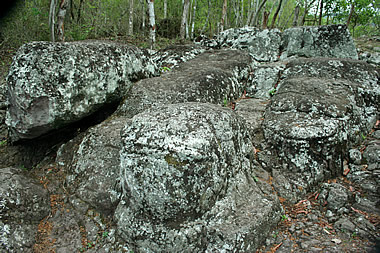
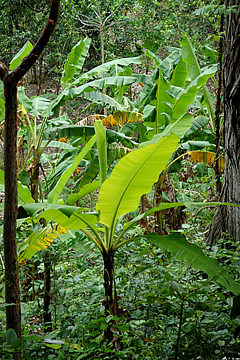
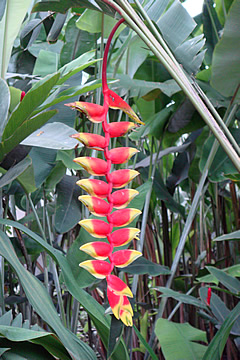
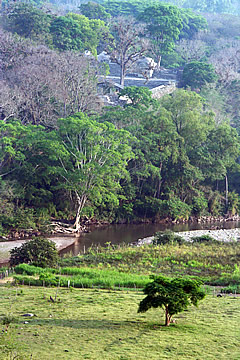
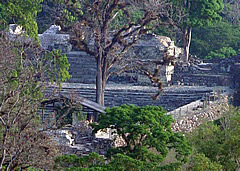
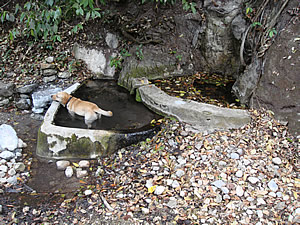
There's not a great deal to see but it's a very nice little excursion, especially when accompanied by one of the hotel dogs who obviously knows the trail well.
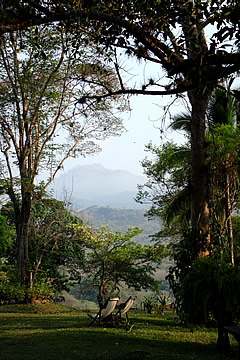
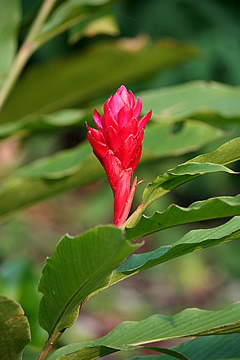
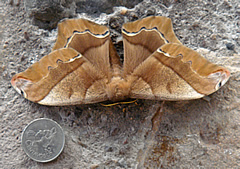
That evening before dinner we watched the sunset from the deck chairs on the San Lucas grounds, high above the Copan River. The following morning we left for Quirigua.
